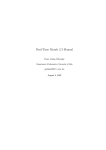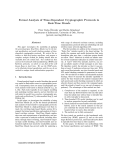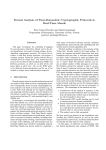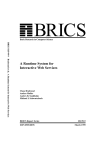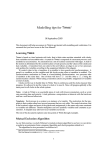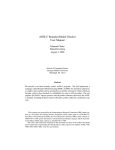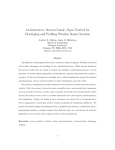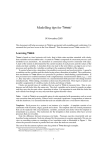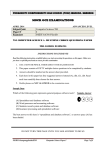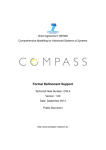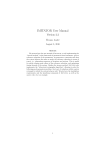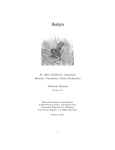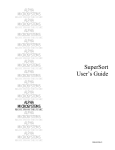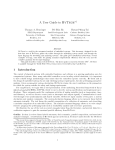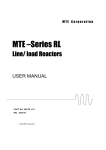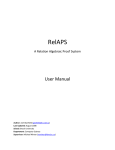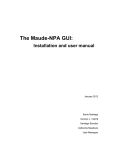Download Real-Time Maude Specification
Transcript
Introduction to Real-Time Maude
Peter C. Ölveczky
University of Illinois at Urbana-Champaign
and
University of Oslo
Based on joint work with José Meseguer
June 2, 2004
UFF
1
Overview
Real-Time Maude extends Maude 2.1 to specify and analyze real-time
and hybrid systems
Specification formalism based on the real-time rewrite theory model
Emphasizes expressiveness and ease of specification, and
performance
Supports specification of object-based real-time systems
Extends Maude’s formal analysis capabilities to real-time systems:
– symbolic simulation for prototyping
– exhaustive state space exploration
– temporal logic model checking
Implemented in Maude as an extension of Full Maude 2.1
June 2, 2004
UFF
2
Motivation
Specify and analyze large real-time systems
Real-Time Maude complements
– finite-control-automaton-based tools (HyTech, U PPAAL, Kronos)
expressiveness, ease of specification, data types, OO
– verification tools (e.g. STeP)
different validation methods, OO
– informal techniques
– networks simulation tools and testbeds
more abstract
wider range of analysis techniques
June 2, 2004
UFF
3
Comparison with Automaton-based Tools
U PPAAL, HyTech, and Kronos successful model checking tools for
real-time systems
– specification formalism: finite control linear hybrid automata
restricted formalism ensures a way of treating dense time
– specification formalism often too restrictive for larger systems
communication; “infinite-control” systems; data types and OO
Real-Time Maude: ease and generality of specification
– expressiveness: system properties not decidable in general
– can not deal with dense time by “clock region”-like constructions
– choice of time sampling strategies to handle dense time
may not cover all “interesting” behaviors
. . . but often sufficient in practice
June 2, 2004
UFF
4
Real-Time Maude Specification
Algebraic equational specification defines the state space
– must include specification of (dense or discrete) time domain
(Ordinary) rewrite rules model instantaneous change
Tick rewrite rules
if
in time
=>
model time elapse
to ensure uniform time elapse
Global state of the form
Many well known models of real-time and hybrid systems can be
naturally expressed in this way
June 2, 2004
UFF
5
Details
must have sort System
State
then has sort GlobalSystem
Time domain must have sort Time, and must interpret zero,
_plus_, and _monus_ (!), etc. on the time domain
Useful predefined modules for time domains can be imported:
–
NAT-TIME-DOMAIN, natural numbers
–
POSRAT-TIME-DOMAIN, nonnegative rationals for dense time
–
NAT-TIME-DOMAIN-WITH-INF, adds a constant INF of
supersort TimeInf
–
POSRAT-TIME-DOMAIN-WITH-INF
June 2, 2004
UFF
6
Example: One Clock
(Retrograde) clock which shows the time:
)}
global state {clock(
dense time domain
clock can stop at any time due to battery failure
clock(24) should be reset to clock(0)
June 2, 2004
UFF
7
Example: A Clock
UFF
June 2, 2004
(tmod DENSE-CLOCK is pr POSRAT-TIME-DOMAIN .
ops clock stopped-clock : Time -> System .
vars R R’ : Time .
crl [tickWhenRunning] :
clock(R) => clock(R + R’) in time R’
if R’ <= 24 - R [nonexec] .
rl [tickWhenStopped] :
stopped-clock(R) => stopped-clock(R)
in time R’ [nonexec] .
rl [reset] :
clock(24) => clock(0) .
rl [batteryDies] :
clock(R) => stopped-clock(R) .
endtm)
8
Challenge: Dense Time
Tick rules “cover” the dense time domain
. . . but are not executable
Specification formalism too general for “clock region” constructions
Tick rules often of form
t
=>
t’
in time x if .../\ x <= u /\ ..
or similar, called admissible, for x a new variable
Choice of time sampling strategies to treat admissible tick rules,
including
– advance time by time
– advance time as much as possible
June 2, 2004
UFF
9
Time Sampling Strategies
Real-Time Maude execution of admissible tick rules relative to
selected time sampling strategy
May not cover all “interesting” behaviors
Time sampling often sufficient in practice
– usually discrete time domain in communication, scheduling, etc.
– things happen because timers expire, messages are read, etc.
June 2, 2004
UFF
10
Example: Setting a Time Sampling Strategy
Set time to advance by 1 in each tick rule application:
Maude> (set tick def 1 .)
– all subsequent Real-Time Maude analysis performed w.r.t. this
strategy
Alternative time sampling strategy advances time as much as possible:
Maude> (set tick max .)
June 2, 2004
UFF
11
Formal Analysis I: Symbolic Simulation
Timed rewriting simulates one possible behavior:
Maude> (trew
clock(0)
in time <= 100 .)
Result ClockedSystem :
stopped-clock(24) in time 100
can trace the rewrite steps
June 2, 2004
UFF
12
Formal Analysis II: Search and Model Checking
To analyze all behaviors, relative to the chosen time sampling strategy,
from initial state
– search for reachable states matching a given pattern
– linear temporal logic model checking
Reachable state space often infinite in larger systems:
– search/model check up to a given duration
– reachable state space then becomes finite (most often)
When reachable state space finite: unbounded search/model checking
No guarantee that all “interesting” behaviors covered
– false positives possible
– a counterexample is a valid counterexample
June 2, 2004
UFF
13
Example: Search
)} (with
Can {clock(
) be reached from {clock(0)}
within time 100?
(tsearch [1]
clock(0) =>* clock(R:Time)
such that R:Time > 24
in time <= 100 .)
Finite reachable state space: unbounded search:
(utsearch [1]
clock(0)
=>*
clock(25)
.)
State {clock(1/2)} not found because of time sampling:
(utsearch [1]
clock(0)
.)
UFF
clock(1/2)
June 2, 2004
=>*
14
Temporal Logic Model Checking
Propositional linear temporal logic
Uses Maude’s high-performance model checker
Not metric temporal logic
– propositions may involve elapsed time (“clocked properties”)
Time bound
termination of model checking
Provides counterexamples
Propositions and formulas are defined in a module which imports
TIMED-MODEL-CHECKER and the module to analyze
June 2, 2004
UFF
15
Example: Defining Propositions
clock-dead: holds if clock has stopped
op clock-dead : -> Prop [ctor] .
vars R R’ : Time .
eq stopped-clock(R) |= clock-dead = true .
clock-is( ): running clock shows
op clock-is : Time -> Prop [ctor] .
eq clock(R) |= clock-is(R’) = (R == R’) .
clockEqualsTime: running clock shows the current time elapse
June 2, 2004
op clockEqualsTime : -> Prop [ctor] .
eq clock(R) in time R’ |= clockEqualsTime
= (R == R’) .
UFF
16
Example: Temporal Logic Model Checking
The clock is never 25:
(mc
clock(0)
|=u [] ˜ clock-is(25) .)
Clock shows elapsed time until time 24 or until it dies:
(mc
clock(0)
June 2, 2004
|=t clockEqualsTime U
(clock-is(24) \/ clock-dead)
in time <= 100 .)
UFF
17
Example: A Thermostat
A very simple thermostat example where a heater is either turned on or off:
turn_on , x=m
x=M
off
.
x=−1
x>=m
turn_off, x=M
on
.
x=2
x<=M
Temperature increases by 2 degrees/time unit when heater turned on, and
decreases by 1 degree/time unit when heater turned off
June 2, 2004
UFF
18
Exercise I: A Thermostat
1. Start Real-Time Maude
2. Model such a simple thermostat, where the thermostat must maintain
a temperature should be between 62 and 74 degrees (it’s Fahrenheit)
3. Global state could have form
must then have sort System
remember:
4. Use a dense time domain
5. Define a time sampling strategy which increases time by 1/2 in each
tick step
6. Define a suitable initial state
7. Execute the specification with timed rewriting (trew) to simulate one
behavior from the initial state within time 1000
June 2, 2004
UFF
19
8. Can you use untimed search on this specification with this time
sampling strategy?
9. Use search to show that it is not possible to reach a state where the
temperature is too cold or too warm
10. Is it possible to reach a state where the temperature is 71 degrees?
11. (If familiar with temporal logic:) import TIMED-MODEL-CHECKER and
the thermostat, and define a proposition goodTemp which holds for
all states where the temperature is within desired interval
12. Use (untimed or timed?) temporal logic model checking to prove that
the temperature is always OK
13. Set the time sampling strategy to a “maximal” strategy, and repeat the
above rewriting, search, and model checking
June 2, 2004
UFF
20
Object-Based Specification
Real-Time Maude particularly well suited for specifying object-based
real-time systems
explicit support for object-based specification in object-oriented timed
modules (syntax (tomod
...
endtom))
all larger Real-Time Maude case studies object-based
developed specification techniques for OO systems
June 2, 2004
UFF
21
OO Specification Techniques
Specification techniques useful in all OO case studies:
tick rule(s) usually similar to
crl [tick] :
C:Configuration
=>
delta(C:Configuration, R) in time R
if R <= mte(C:Configuration) [nonexec] .
R new variable
–
delta models effect of time elapse
–
mte gives maximum possible time elapse before some
–
time domain covered
instantaneous action must be taken
–
delta and mte are frozen operators
–
delta and mte distribute over the elements in a configuration
June 2, 2004
UFF
22
Example: Many OO Clocks
Object-oriented specification of multiple clocks:
(tomod MANY-DENSE-OO-CLOCKS is
protecting POSRAT-TIME-DOMAIN-WITH-INF .
class Clock | state : ClockState,
value : Time .
sort ClockState .
ops running stopped : -> ClockState [ctor] .
var O : Oid .
rl [reset] :
< O : Clock | state : running, value : 24 >
=> < O : Clock | state : running, value : 0 > .
June 2, 2004
UFF
23
Example: Many OO Clocks II
rl [failure] :
< O : Clock | state : running > =>
< O : Clock | state : stopped > .
vars C C’ : NEConfiguration .
vars R R’ : Time .
June 2, 2004
crl [tick] :
C
=>
delta(C, R) in time R
if R le mte(C) [nonexec] .
UFF
24
Example: Many OO Clocks III
op mte : NEConfiguration -> TimeInf [frozen (1)] .
eq mte(C C’) = min(mte(C), mte(C’)) .
eq mte(< O : Clock | state : running,
value : R >) = EXERCISE!! .
eq mte(< O : Clock | state : stopped,
value : R >) = EXERCISE!! .
June 2, 2004
UFF
25
Example: Many OO Clocks IV
op delta : NEConfiguration Time ->
NEConfiguration [frozen (1)] .
eq delta(C C’, R) = delta(C, R) delta(C’, R) .
eq delta(< O : Clock | state : running,
value : R >, R’) =
EXERCISE!! .
eq delta(< O : Clock | state : stopped >, R) =
EXERCISE!! .
endtom)
June 2, 2004
UFF
26
Exercise II: OO Clocks
1. Complete the above specification of OO clocks by defining mte and
delta on Clock objects
2. Define an initial state with three clocks
op initState : -> GlobalSystem .
.
eq initState =
remember to define some values of sort Oid for the object names
3. Define a suitable time sampling strategy
4. Execute your specification using timed rewriting
5. Search for a state where some clock has value
June 2, 2004
UFF
> 24
27
Rest of Exercises
Simple ways of “computing” the round trip times between pairs of objects
basis for many communication protocols
OO: each “node” in the network corresponds to an object
need a “clock” component in each node (no death or reset)
need to model time it takes a message to travel between a pair of
objects
look at different settings
“real” Real-Time Maude case study uses sophisticated modeling of
delays and congestion in links
June 2, 2004
UFF
28
Exercise III: Clock Attribute
1. Specifiy a OO system where each Node object has one attribute
clock which shows the accumulated time (no reset/death of clocks)
can use discrete time domain
2. Define a time sampling strategy which increases time by 1
3. Define an initial state with three Node objects, each with clock
value 0
4. Execute the specification
5. Use search to show that a state where one clock has value 100 can
be reached
6. Use search to show that all the nodes have the same clock values all
the time (possibly up to time 100)
June 2, 2004
UFF
29
Modeling Message Delays
To model message “delays” can have an operator
op dly : Msg Time -> Msg .
) denotes a “message” which will become
,
such that dly(
in time
from now
Nice idea:
op dly : Msg Time -> Msg [idr: 0] .
June 2, 2004
dly( , 0) is now seen exactly as
–
UFF
by Real-Time Maude!
30
Exercise IV: Delays
Define the function delta on dly-messages and on normal messages
mte is more tricky
depends on the context
June 2, 2004
UFF
31
First RTT Protocol
Class Node:
class Node | clock : Time, nbr : Oid,
dlyToNbr : Time, rttToNbr : Time .
nbr is the address to the neighbor node
dlyToNbr is the exact time it takes for a message to reach the
neighbor
rtt is the desired RTT value to the neighbor we want to find
June 2, 2004
UFF
32
First RTT Protocol (cont.)
Protocol:
reads the findRtt(
) message, it sends an
2. When node
) message, it responds with
) (with same ) message back to its neighbor, with
an rttAck(
reads an rttReq(
is the “timestamp,” its
rttReq( ) message to its neighbor, where
current clock value
3. When a node
) message kicks off the protocol for node
1. A findRtt(
appropriate delay
) message, it computes the
4. When a node receives a rttAck(
desired rttToNbr value as the difference between the timestamp
and its current clock value
June 2, 2004
UFF
33
First RTT Protocol (cont.)
A typical initial state could be
ops n1 n2 n3 n4 : -> Oid .
op initState : -> GlobalSystem .
eq initState =
findRtt(n1)
findRtt(n3)
findRtt(n4)
< n1 : Node | clock : 0, nbr : n3,
dlyToNbr : 2, rttToNbr : 0
< n2 : Node | clock : 0, nbr : n4,
dlyToNbr : 1, rttToNbr : 0
< n3 : Node | clock : 0, nbr : n1,
dlyToNbr : 3, rttToNbr : 0
< n4 : Node | clock : 0, nbr : n2,
dlyToNbr : 2, rttToNbr : 0
>
>
>
>
.
June 2, 2004
UFF
34
Exercise V: Simple RTT
1. What should be the “result” of the system from initState?
2. Specify and execute the protocol with the given initial state
3. Check whether each state reachable in exactly time 6 has the correct
rttToNbr values
hint: search for a state reachable in time 6 with some incorrect
rttToNbr value
June 2, 2004
UFF
35
Example: New RTT Setting
A message may now take any amount of time
the minimum delay to
reach its destination
nondeterministic traveling time for a message (models different
network load, etc.)
hint: consider mte on messages
the actual protocol is the same!
June 2, 2004
UFF
36
Exercise VI: New RTT Setting
1. Modify your previous solution to the new setting, and execute your
specification
2. Show that a message can indeed travel any time by
proving that it is possible to reach a state in which both nodes have
recorded an rttToNbr value 2
proving that it is possible to reach a state where n1 has recorded
rttToNbr 4 and n2 has recorded rttToNbr value 5
from initial state
findRtt(n1)
findRtt(n2)
< n1 : Node | clock : 0, nbr : n2,
dlyToNbr : 1, rttToNbr : 0 >
< n2 : Node | clock : 0, nbr : n1,
dlyToNbr : 1, rttToNbr : 0 >
June 2, 2004
UFF
37
Example: New RTT Protocol
Communication model unchanged
Protocol has changed:
– if an rttAck message is not received within time MAX-RTT,
then something went very badly, and we instead initiate a new
round of the protocol to find a OK rtt value
– each time a node sends a rttReq message, it also turns on a
timer which must “ring” in time MAX-RTT
– if an rttAck message is received which indicates an rtt value ¡
MAX-RTT: everything OK, record rtt value and turn off timer
– if timer rings: start new attempt and set timer to ring in time
MAX-RTT
– “old” messages are just ignored
June 2, 2004
UFF
38
Exercises VII: New RTT Protocol
(If time)
1. Model the protocol described above in Real-Time Maude
if it
hint: a timer can be modeled by an attribute with a time value
must “ring” in time , and with a value INF if it is turned off
2. Execute the protocol
3. Use search to show that the protocol does not record any rtt value
MAX-RTT (within reasonable time)
June 2, 2004
UFF
39
Larger Case Studies in Real-Time Maude
AER/NCA: new state-of-the-art protocol suite for scalable, adaptive,
and reliable multicast in active networks
– object-based formal specification from UML-like informal
specification
– Real-Time Maude analysis uncovered all design errors discovered
by traditional testing, and some more
Proposed new IETF multicast protocol
New and advanced scheduling algorithms
Wireless sensor network protocols
June 2, 2004
UFF
40
Concluding Remarks
Formalism emphasizes generality and ease of specification
– suitable for object-based specification
Range of high-performance analysis capabilities
Complements automaton-based model checkers, verification tools,
informal specification techniques, and simulation tools
Tested in substantial case studies
Suggested OO specification techniques useful in practice
Tool, user manual, related papers, and examples available from
http://www.ifi.uio.no/RealTimeMaude
and from the Maude page
June 2, 2004
UFF
41
Future Work
Identify cases in which a time sampling strategy covers all behaviors
Develop other abstraction techniques
Deal with dense time
Stochastic time increase strategies for simulation purposes
Case studies
. . . and much more
June 2, 2004
UFF
42










































